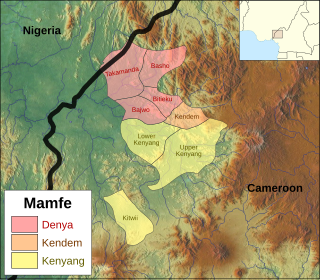| Kenyang | |
|---|---|
| Nyang | |
| Native to | Cameroon |
Native speakers | (65,000 cited 1992) [1] |
| Dialects |
|
| Latin | |
| Language codes | |
| ISO 639-3 | ken |
| Glottolog | keny1279 |
 Kenyang | |
Kenyang (Nyang, Banyang, Manyang) is the most spoken language of the Mamfe language group. It is spoken in the Manyu and Meme departments of the Southwest Region of Cameroon. Kenyang speakers in Cameroon are known as Bayangi (Bayangui) people and are called Bayangi (Bayangui).
Contents
There are three main dialects of Kenyang: Lower Kenyang, spoken in Eyumojock and Mamfe Central subdivisions, Upper Kenyang, spoken in Upper Bayang subdivision and Kitwii, spoken in Meme department. The Upper Kenyang and Lower Kenyang dialects are more closely related to each other than to Kitwii. [2] Variant names of Kitwii include, Kicwe, Twii, Bakoni, Northern Balong, Upper Balong and Manyeman.